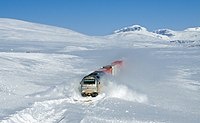
Photo from wikipedia
Mapping the spatial extent of recently identified englacial hydrological features (i.e., ice slabs and perennial firn aquifers) formed by meters-thick water-saturated firn layers over the percolation facies of the Greenland… Click to show full abstract
Mapping the spatial extent of recently identified englacial hydrological features (i.e., ice slabs and perennial firn aquifers) formed by meters-thick water-saturated firn layers over the percolation facies of the Greenland Ice Sheet using L-band microwave radiometry has recently been demonstrated. However, these initial maps are binary, and do not provide a parameter to estimate the spatial variability in the thickness and volumetric fraction of meltwater stored within the firn pore space. Here, we exploit enhanced-resolution vertical-polarization L-band brightness temperature ($T_{V}^{B}$) imagery (2015–2019) generated using observations collected over Greenland by NASA’s Soil Moisture Active Passive (SMAP) satellite and a simple two-layer L-band brightness temperature model. We map water-saturated firn layers via a “firn saturation” parameter, and interpret our results together with ice slab and perennial firn aquifer spatial extents, estimates of snow accumulation simulated via the Regional Atmospheric Climate Model (RACMOp2.3), and airborne radar surveys collected via NASA’s Operation IceBridge (OIB) campaigns. We find that variable firn saturation parameter values are mapped in lower snow accumulation ice slab areas in western, northern, and northeastern Greenland, where firn is colder and water-saturated firn layers seasonally refreeze as solid-ice. Higher firn saturation parameter values are mapped in higher snow accumulation perennial firn aquifer areas in southeastern, southern, and northwestern Greenland, where firn is near the melting point, and meters-thick water-saturated firn layers exist. Our results have implications for identifying expansive englacial reservoirs that store significant volumes of meltwater in locations that are vulnerable to meltwater-induced hydrofracturing and accelerated outlet glacier flow year-round.
Journal Title: IEEE Journal of Selected Topics in Applied Earth Observations and Remote Sensing
Year Published: 2022
Link to full text (if available)
Share on Social Media: Sign Up to like & get
recommendations!